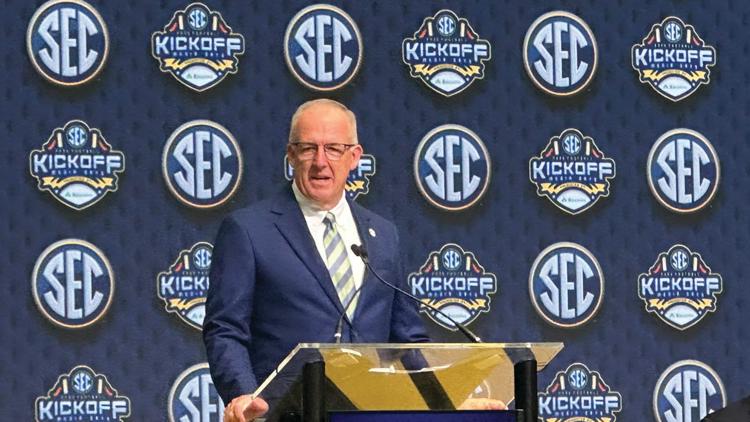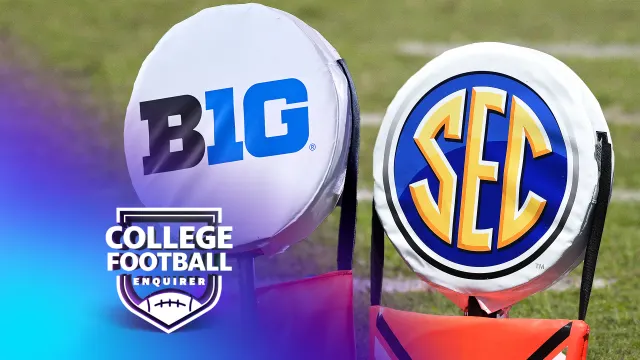The future of college football could be decided not on the field, but behind closed doors. A growing standoff between the SEC and Big Ten over the post-2025 College Football Playoff (CFP) format is threatening to reshape the entire financial ecosystem of college athletics. What seems like a policy debate is really a battle over power, influence, and billions in media revenue.
🔍 Key Facts or Breaking News Details
- Timeline: The 12-team CFP format is confirmed through the 2025 season. Negotiations are underway for the 2026–2031 structure.
- Parties Involved: SEC Commissioner Greg Sankey and Big Ten Commissioner Tony Petitti are leading discussions.
- Current Deadlock: The two conferences, despite collaborative authority, are at odds on how the playoff spots should be distributed moving forward.
- Big Ten Proposal (4-4-2-2-1): 4 automatic bids each to the SEC and Big Ten, 2 to the ACC and Big 12, and 1 for a Group of Five team.
- SEC Proposal (5 Conference Champs + 11 At-Large): 5 highest-ranked champions get in, and the remaining 11 spots are open to any high-performing teams.
This conflict isn’t just philosophical—it’s financial. With projected playoff revenues surging into the billions, the structure chosen could lock in a new economic hierarchy for years to come.

💸 Money Angle / Wealth Perspective
The expanded College Football Playoff is set to become a financial juggernaut.
- Current Media Deal: ~$470 million annually with ESPN.
- Projected New Deal: $1.3 billion to $2.2 billion annually from 2026 onward.
- What’s Driving This?
- More high-stakes playoff games
- National advertising demand
- Increased sponsorship value
- Record-breaking ticket sales and merchandise from CFP teams
The fight isn’t about whether the playoff is valuable—it’s about who gets the largest slice of the future revenue pie and how that shapes the financial future of the sport.
📈 Career or Performance Background
Big Ten’s Proposal: 4-4-2-2-1 Model
This format locks in a predictable, guaranteed playoff presence for the SEC and Big Ten regardless of year-to-year performance.
Financial Ramifications:
- Revenue Stability: Elite programs in the SEC and Big Ten can plan long-term financially, knowing they’ll almost certainly qualify annually.
- Recruiting Advantage: Guaranteed playoff spots become massive recruiting tools and selling points to high school athletes.
- Institutional Expansion: With fixed access to CFP revenue, schools can confidently invest in facilities, coaching, and NIL collectives.
- Deepening the Divide: ACC, Big 12, and Group of Five conferences would receive fewer opportunities, reducing their access to playoff revenue and increasing the financial gap.
This model ensures the “Power Two” maintain dominance and control the lion’s share of postseason earnings.
SEC’s Proposal: 5 + 11 At-Large
While appearing more democratic, this format cleverly funnels most at-large bids to SEC and Big Ten teams based on strength of schedule, ranking, and brand value.
Financial Ramifications:
- Ratings Optimization: Matchups featuring legacy powerhouses bring higher TV ratings, increasing the playoff’s overall media value.
- Performance-Based Payouts: No guaranteed slots for struggling power conference teams; CFP income becomes performance-driven.
- Meritocracy Illusion: Though open to all, the reality is that high-level programs in the SEC and Big Ten will likely still earn 8–10 spots annually.
Both models are about money—but while the Big Ten seeks financial security, the SEC wants high ceilings and dynamic growth.

🌟 Brand, Influence & Culture Impact
The CFP isn’t just about the games. Its structure dictates:
- Recruiting Flow: Top players follow playoff paths and exposure. Teams with consistent CFP access get the best talent and NIL leverage.
- NIL Opportunities: CFP visibility = bigger brand deals for athletes. More games = more camera time = more sponsorship.
- University Prestige: Consistent playoff appearances raise national profiles, boost applications, and attract more donations—athletic and academic.
- Conference Stability: Wealthier, playoff-driven leagues reduce realignment risks. Schools are less likely to jump if their current conference can feed them revenue and relevance.
The playoff format literally shapes the culture, media exposure, and identity of entire conferences and schools.
📌 The Distinct Athlete Angle
This standoff is peak college football capitalism—conferences using structure to secure generational wealth. At Distinct Athlete, we follow the moves behind the scoreboard, and this is one of the biggest.
- The Big Ten’s plan guarantees playoff income for elite schools regardless of down seasons.
- The SEC’s plan rewards dominance and ratings appeal—still benefiting the top but based on actual wins.
- Both models protect their conferences, but neither is rooted in fairness for smaller leagues.
This is a power chess match—where who gets in the playoff will dictate who gets the biggest stadiums, the best recruits, and the deepest wallets for the next decade.

🔗 Related Reads on Distinct Athlete
➡️ Jimbo Fisher’s $75M Buyout: Where Coaching Contracts Went Wild
➡️ NIL Economics: How Top Players Are Monetizing the Playoff Spotlight
➡️ SEC vs. Big Ten: The Battle for College Football’s Future
💬 Join the Conversation
Which playoff format do you think is best for the sport? Should access be guaranteed for conferences—or earned every year on merit?
Let us know in the comments and follow @DistinctAthlete for more on college football’s money game.

